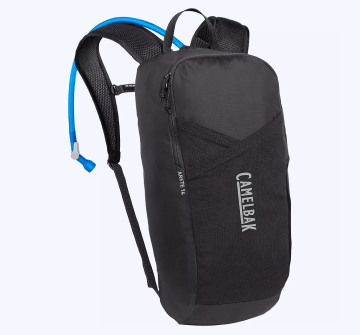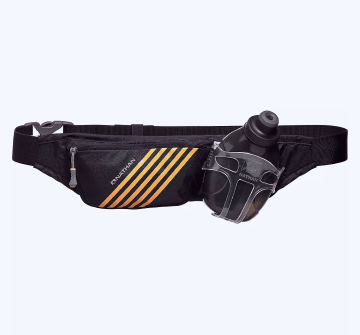Hiking Water & Hydration: Learn How Much You Need

You can’t explore the limits of your next favorite trail without staying hydrated. That clear stream flowing close to your path may look safe enough to drink, but hazards like bacteria or parasites often linger in unpurified water sources.So how can you improve your odds of avoiding dehydration, sunstroke, or worse when you’re in the most remote areas? Keep reading to better understand how much water you should bring on a hike as well as what gear we recommend you have before you head out.
Key Takeaways
- How Much Water for Hiking Do You Need? Uncover how much water you should be drinking based on how many hours you hike and temperature conditions.
- Best Methods to Carry Your Hiking Water: Learn about what items you should consider for carrying water by hand, on your back, or around your waist.
- Finding Water Sources + Purification Methods: If you’re ever in a dire situation, find out how to locate water sources and purify water so it’s safe to drink.
- Tips for Staying Hydrated on a Hike: Uncover our top tips to increase your fluid intake on a long hike.
- Signs of Dehydration: Learn the telltale signs of dehydration to prevent mild or severe cases of dehydration.
How Much Water for Hiking Is Needed?
In mild weather, carry at least half a liter of water for every hour you plan to be out. In extreme conditions, you need to drink at least a quart per hour. Dehydration can strike quickly — so always be prepared.Although this is the standard recommendation, every hiker is different. You may have certain medical considerations others don’t. Planning your hiking trip in advance and how much water you’ll need is the best way to stay safe no matter where you go. When in doubt, ask your doctor for their recommendations.
A good habit to practice is drinking a liter of water either just before or as you begin your hike. Here are our other recommendations:
-
Sip your water throughout the hike — but not all at once. Hydrate before, during, and after your hike.
-
Carry your hiking water in a hydration pack or water bottle for easy sipping access.
Expert Tip:
Your hydration needs can vary based on factors like age, humidity, intensity, and even blood type. Just because you don’t feel thirsty doesn’t mean you should stop drinking water.
How Much Water to Bring on a Hike
Take a look at our day hiking water recommendation chart to gauge how much water you need. Keep in mind that these are general estimates. Actual liters you’ll need can greatly vary based on factors like humidity, time of day, your weight, health conditions, and more.
| Day Hiking Water Recommendation | ||
|---|---|---|
| Hours | Liters for Moderate Conditions | Liters for Hot/Extreme Conditions |
| 1 | 0.5 | 1 |
| 2 | 1 | 2 |
| 3 | 1.5 | 3 |
| 4 | 2 | 4 |
| 5 | 2.5 | 5 |
| 6 | 3 | 6 |
| 7 | 3.5 | 7 |
| 8 | 4 | 8 |
| 9 | 4.5 | 9 |
| 10 | 5 | 10 |
| 11 | 5.5 | 11 |
| 12 | 6 | 12 |
When you're trekking and/or backpacking overnight, you exert more effort and energy. That means you’ll need extra water. But lugging a lot of liters on your shoulders for days isn't too feasible.To lighten the load of your pack, use water purification or trailside refill stations if available. However, don’t leave home without your hydration pack! You can fill it up along the way with the recommended amount of water for your adventure. Remember that our charts only show general estimates.
| Trekking/Backpacking Water Calculator | ||
|---|---|---|
| Days | Liters for Moderate Conditions | Liters for Hot/Extreme Conditions |
| 1 | 12 (0.5 x 24) | 24 (1 x 24) |
| 2 | 24 (0.5 x 48) | 48 (1 x 48) |
| 3 | 36 (0.5 x 72) | 72 (1 x 72) |
| 4 | 48 (0.5 x 96) | 96 (1 x 96) |
| 5 | 60 (0.5 x 120) | 120 (1 x 120) |
| 6 | 72 (0.5 x 144) | 144 (1 x 144) |
| 7 | 84 (0.5 x 168) | 168 (1 x 168) |
Expert Tip:
For longer hikes, stash extra bottled water in an insulated cup in your car. This ensures you have fresh water waiting post-hike. It's a handy backup — especially if you've depleted your supply on the trail.
Best Methods to Carry Hiking Water
Your hiking water should be both easy to carry and remain cold throughout the duration of your hike. Steer clear of plastic bottles — they're not only less environmentally friendly but also less effective at keeping your drink cool in warmer weather.
Carry by Hand

Choose insulated or stainless steel water bottles. Shop trusted brands such as Stanley and YETI. These bottles feature carry handles and come in different sizes (18-64 oz.)
- Insulated drinkware is reusable. Some cups have straw spouts and special designs.
- These water bottles come in a variety of sizes to choose from (18-64 oz.). Opt for larger sizes for more intense hikes.
Wear on Your Back

If you don’t physically want to carry a water bottle in your hands, hydration packs are the answer! You wear them like you would a backpack.
- Hydration packs come in a range of sizes (2-100 oz.) to help you stay hydrated. Larger sizes are better suited for long-distance hikes.
- Fill your hydration pack with ice cubes for ice-cold water. These can also be worn for runs, hikes, and even motorcycle rides.
Wear Around Your Waist

A hydration belt features built-in cup holders to hold bottles around your waist. They are commonly used in the running world.
- The amount of water you can carry with a hydration belt tends to be smaller — typically around 22 liters. Some belts come with two water bottles for increased capacity, though.
- Some hydration belts also feature zipper pockets to hold your keys and cash. Shop a variety of designs and sizes.
Finding Water Sources + Purification
On extended adventures, carrying all the hiking water you need from the outset might be impractical. But don't fret if you can't immediately find a water source while on the trail. You have a few different options for purifying natural water sources.

Streams, Rivers, or Lakes
-
If you stumble upon a dry stream, don't give up immediately. Follow its path downstream. There's a chance you might find water further along.
-
While streams, rivers, or lakes can be tempting sources, it's essential to be cautious. Always purify any water from these sources before you consume them to avoid any potential health risks.
Digging in the Ground
Stumbling upon a patch of damp, green grass while hiking can be a promising sign of hidden water beneath. If you dig a small hole nearby, it just might fill up with water. Use your hands or a bandana to soak up the water and transport it to your water bottle. This method can be a lifesaver when other water sources are scarce.
Purifying Water Before Drinking It
When you stumble upon a water source during your hike, you need to purify it so it's safe for consumption. Harmful bacteria and other hazards can linger even in the clearest water sources.
-
Always inspect the water for signs of animal waste or extreme murkiness. Refrain from drinking directly from an unfiltered source to prevent illness.
-
You can purify water with a water purification system or even a water purification straw — such as LifeStraw. This is great to use for emergencies, camping trips, and more.
-
If you have cooking gear, boiling the water is another effective purification method. Boil your water in a pot for 3-5 minutes and then allow it to cool.

Tips for Staying Hydrated On a Hike
-
Drink Throughout Your Hike: Take small sips of water frequently. Make sure to drink even if you don’t think you’re sweating. Setting a timer can help remind you to drink in cold weather and at high altitudes.
-
Replenish With Electrolytes: Too much water can deplete electrolytes. Take electrolyte supplements during your hike. You can also replenish potassium by eating salty snacks like pistachios.
-
Drink Before & After Your Hike: If you're gearing up for a demanding hike, hydrate by drinking about 16 fluid ounces a couple of hours before you set out. After your hike, rehydrate! Aim for at least one glass of water.
-
Plan Your Water Stops: Before heading out, study your route to identify potential water stops. This will also help you gauge the amount of water you can comfortably carry with you.
-
Stay Cool: Wear a hat and sunglasses to shield yourself from the heat. Protect your skin with sunscreen. Also, consider draping a cooling towel around your neck to regulate your body temperature. Opt for light-colored hiking clothes as well.
How to Prevent Overhydration + Tips
Navigating the balance between staying hydrated and overhydrating is essential for a safe hiking experience. Aim to drink around 10 fluid ounces every 20 minutes.
-
Overhydration can be as dangerous as dehydration. Hyponatremia can lead to symptoms like fatigue, headaches, and nausea.
-
Always listen to your body's signals, and adjust your intake accordingly. Be sure to balance your water consumption with snacks to maintain electrolyte levels.
-
It's not just about quantity. Your water intake pace also matters! Take small, frequent sips rather than gulping down a large quantity of water at one time.

Signs of Dehydration
-
Feeling Sluggish: A sudden feeling of weakness or sluggishness can indicate early dehydration. Always listen to your body's signals. If you feel faint, take a moment to rest and hydrate.
-
Dark Urine: Brown urine is a red flag for dehydration and a sign you need to drink more water. Ideally, your urine should be a pale yellow.
-
Headaches + Cramps + Nausea: These symptoms can be initial indicators of dehydration. Ensure you hydrate promptly when any of these occur.
Expert Tip:
Pinch the skin on the back of your hand to quickly tell if you’re dehydrated. If it snaps back quickly, you're likely hydrated. If it returns slowly, you’re most likely dehydrated (or getting there). Learn more about the pinch test by visiting MedlinePlus.
Have Fun Out There!
Ready to conquer another hiking trail? No matter the season, staying hydrated is key! At Academy, we offer top-tier water bottles and hydration packs to ensure you have refreshing water at every step of your journey.


